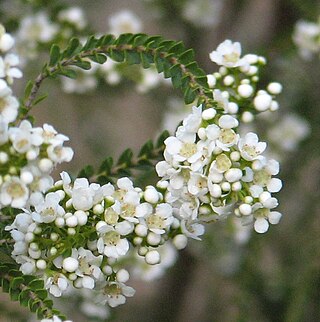
Myrtaceae, the myrtle family, is a family of dicotyledonous plants placed within the order Myrtales. Myrtle, pōhutukawa, bay rum tree, clove, guava, acca (feijoa), allspice, and eucalyptus are some notable members of this group. All species are woody, contain essential oils, and have flower parts in multiples of four or five. The leaves are evergreen, alternate to mostly opposite, simple, and usually entire. The flowers have a base number of five petals, though in several genera, the petals are minute or absent. The stamens are usually very conspicuous, brightly coloured, and numerous.

Astartea is a genus of flowering plants in the myrtle family, Myrtaceae. The genus is endemic to southwestern Western Australia. The genus name was inspired by Astarte, the Greek name for the goddess Ishtar.

Thryptomene is a genus of flowering plants in the family Myrtaceae and is endemic to Australia. Plants in the genus Thryptomene are shrubs with small leaves arranged in opposite pairs and white or pink flowers. About forty-seven species of Thryptomene, occurring in all Australian states and the Northern Territory, have been formally described.

Scholtzia is a genus of flowering plants in the family Myrtaceae, which are endemic to the south-west of Western Australia. The genus was first described by Schauer in 1843, who named it in honour of the physician Heinrich Scholtz. The type species is Scholtzia obovata.
Seorsus is a genus of flowering plants in the family Myrtaceae. The occurrence of the four species in Australia and Borneo is widely spaced, and is thought to be indicative that the genus predates the breakup of Gondwana.

Chamelaucieae is a tribe of flowering plants within the family Myrtaceae, mostly from Australia, with a few species in New Caledonia and south-east Asia.

Aluta is a genus of small shrubs in the family Myrtaceae. Species occur in Western Australia, South Australia and the Northern Territory. When the genus was erected in 2000, three species were transferred from the genus Thryptomene.

Rinzia is a genus of flowering plants in the family Myrtaceae. The genus was first formally described in 1843 and reinstated and revised in 1986.

Cheyniana is a genus of flowering plants in the family Myrtaceae. Two species are currently recognised, both endemic to Western Australia:

Dicrastylis is a genus of plants in the Lamiaceae, first described in 1855. The entire genus is endemic to Australia. The type species is Dicrastylis fulva.

Malleostemon is a genus of flowering plants in the myrtle family Myrtaceae, described as a genus in 1983, by John Green The entire genus is endemic to Western Australia.
- Malleostemon costatusRye & Trudgen
- Malleostemon decipiens(W.Fitzg.) Trudgen
- Malleostemon hursthousei(W.Fitzg.) J.W.Green
- Malleostemon microphyllusRye & Trudgen
- Malleostemon minilyaensisJ.W.Green
- Malleostemon nephroideusRye
- Malleostemon nerrenensisRye & Trudgen
- Malleostemon pedunculatusJ.W.Green
- Malleostemon peltiger(S.Moore) J.W.Green
- Malleostemon pustulatusRye
- Malleostemon roseus(E.Pritz.) J.W.Green
- Malleostemon tuberculatus(E.Pritz.) J.W.Green
- Malleostemon uniflorusRye

Cyathostemon ambiguus is a member of the family Myrtaceae endemic to Western Australia.

Cyathostemon blackettii is a member of the family Myrtaceae endemic to Western Australia.

Hypocalymma myrtifolium is a species of flowering plant in the myrtle family Myrtaceae, and is endemic to a restricted area in the south west of Western Australia. It is an erect shrub with egg-shaped to elliptic leaves and white or cream-coloured flowers with 30 to 50 stamens in several rows.

Hypocalymma speciosum is a species of flowering plant in the myrtle family Myrtaceae, and is endemic to the Stirling Range in southern Western Australia. It is a bushy shrub with heart-shaped, egg-shaped or circular leaves and deep pink-purple flowers with 25 to 50 stamens in several rows.

Thryptomene mucronulata is a species of flowering plant in the family Myrtaceae and is endemic to Western Australia. It is an erect shrub with upward-pointing, overlapping, egg-shaped leaves with the narrower end towards the base and pink flowers with five petals and ten stamens.
Enekbatus cryptandroides is a shrub endemic to Western Australia.
Malcolm Eric Trudgen is a West Australian botanist. He has published some 105 botanical names. He currently runs his own consulting company, ME Trudgen and Associates.
Astus is a genus of flowering plants belonging to the family Myrtaceae.
Hysterobaekea is a genus of flowering plants in the myrtle family (Myrtaceae). The genus is endemic to Australia, and includes 11 species found in the states of Western Australia, South Australia, and Victoria.















